Art & Science Collaborations, Inc. (ASCI) Presents:
The 17th annual art-sci international juried exhibition,


Biodiversity/Extinction
October 10, 2015 – February 28, 2016
Artists Reception: November 8, 2015
The New York Hall of Science
47-01 111th Street, Corona, Queens, NYC
in Flushing Meadows Park
Distinguished Co-Jurors:
Elizabeth Corr, Manager of Art Partnerships at the Natural Resources Defense Council, and
Dr. Paula J. Ehrlich, President & CEO of the E.O. Wilson Biodiversity Foundation
Selected Artists & Scientists:
Hetty Baiz (USA), Elizabeth Bajbor (Poland), Bengtson+Wetherwax (USA), Bec Bigg-Wither (Australia), Don Cooper (USA), Donna Davis (Australia), Gina Duque (Canada), Michael Felber (USA), Jon Goldman (USA), Angela Gonzalez (USA) Jaden J.A. Hastings (USA), Joseph Ingoldsby (USA), Lea Kannar-Lichtenberger (Australia), Jennifer Kim Sohn (USA), Beth Krensky (USA), JM Landin (USA), Lee Lee (USA), Dash Masland (USA), Nadir+Peppermint (USA), Yoko Shimizu (Japan), Lauren Strohacker (USA),
Ashley Williams (USA), and Jon Wyatt (UK)

Art That Fuels Reflection, Critical Thinking, and Hopefully Action on Today’s Biodiversity/Extinction Crisis
New York, NY (October 28, 2015) Throughout history, visual artists have been inspired to capture the complex as well as the sublime qualities of nature and its life-forms. Scientists have done the same via observational recording, classification, counting, and analysis. Because of their baseline reports, we now know the truths of today’s rapidly-increasing biodiversity/extinction crisis. Additionally, the science of ecology, tells us how this loss affects every human, as we are the interconnected “top predator” of all life on planet Earth.
The artists and scientists in this year’s Art & Science Collaborations’ SCIENCE INSPIRES ART: Biodiversity/Extinction exhibition at the New York Hall of Science, on view from October 10, 2015 – February 28, 2016, were selected by distinguished Co-Jurors: Elizabeth Corr, Manager of Art Partnerships at the Natural Resources Defense Council, and Dr. Paula J. Ehrlich, President & CEO of the E.O. Wilson Biodiversity Foundation. Combing scientific knowledge with methods from their artistic toolbox, the show’s participants allowed their feelings of deep concern to guide their ultimate mission – for their art to stimulate public
reflection, critical thinking, dialogue, and hopefully individual actions on the issues we face surrounding loss of biodiversity and species extinction.
Below is an overview of the aesthetic communication strategies employed by the 23 artists and scientists in this exhibition, represented by 2D prints of their original artworks executed in various media: installation, painting, mixed-media, collage, digital imagery, photography, video, illustration, 3D sculptural objects, and even “microbial selfies.”
THE PULL OF HUMOR:
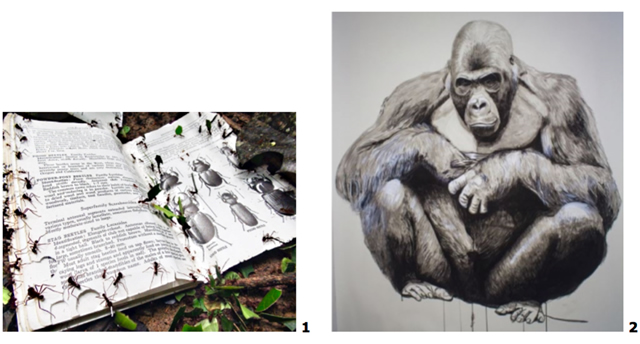

(1) Bengtson+Wetherwax turn a scientific field experiment into an amusing inter-species cultural exchange in their mixed-media video work called Teaching Aid.
(2) Jon Goldman’s provocative Aphoristic Extinctions series is a pithy observation of how humans use language to cynically express fear and justify estrangement from wild animals.
ART AS CONSERVATION ACTION:
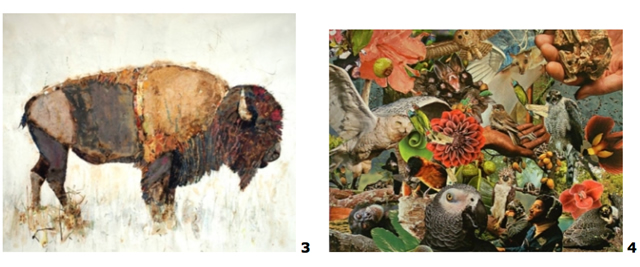

(3) Hetty Baiz’s early and deep connection to the importance of nature’s web-of-life, translates easily into her recent collage series of magnificent wildlife threatened by extinction.
(4) Bec Bigg-Wither’s collage, I’d Kill To Be Like You – Air, is an ode to the freedom of our feathered aviators of the sky, while lamenting that science alone cannot protect them.
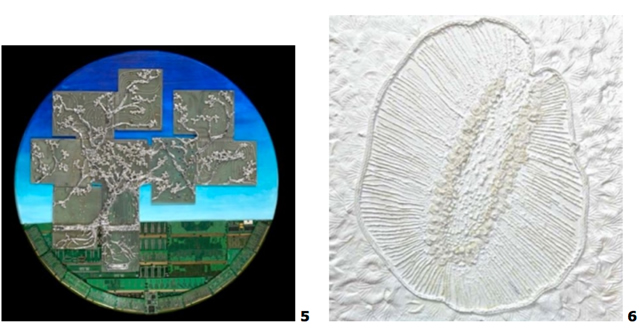

(5) Angela Gonzalez’s mixed-media artwork, BIOS – Basic Input Output System, heralds the life-sustaining systems of trees and the necessity for a balance between people, planet, and profit.
(6) Gina Duque’s mixed-media works on canvas celebrate the structure and power of seeds to sustain human civilizations with their common ability to survive long periods in dry, barren lands.
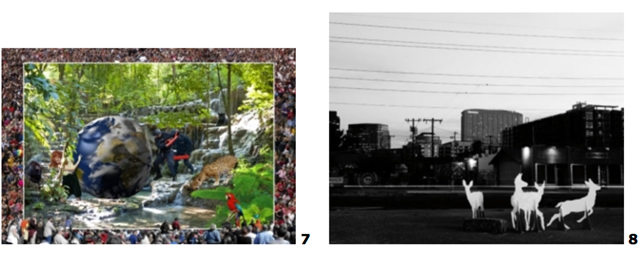

(7) Don Cooper’s digital collage illustrations are a “call to action” on behalf of our planet,
acknowledging that both negative and positive collective actions can make a difference.
(8) Lauren Strohacker’s Encounter project places free-standing cut-outs of mule deer in downtown Phoenix to stimulate dialog about cohabitation versus conflict in our current Anthropocene Era.
KNOWLEDGE IS POWER:
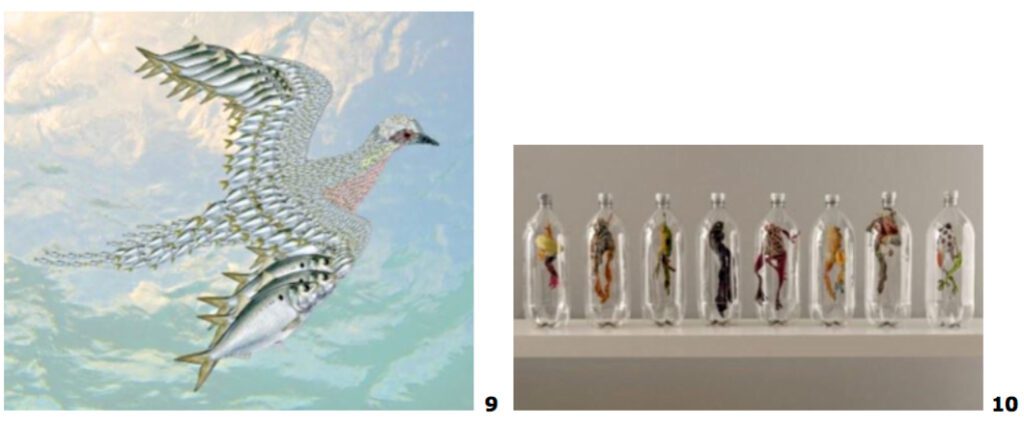

(9) Joseph Ingoldsby’s poignant 2D “memorial,” The Last Migration, reflects on the loss of two keystone bird and fish extinctions by man’s actions over just a 100-year time-span.
(10) Jennifer Kim Sohn’s Toxic Habits questions “green” advertising claims by exposing the real ecological costs of today’s textile production processes, including “natural cotton.”
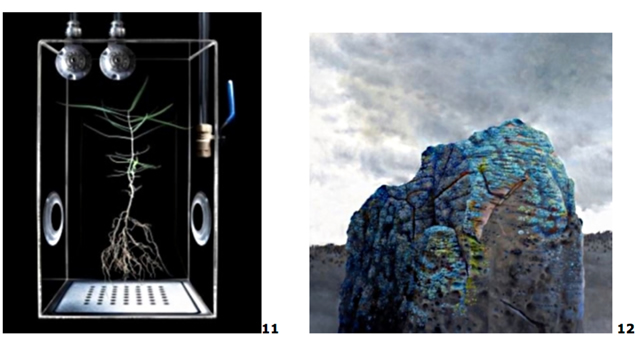

(11) Donna Davis’ digital print, Life Support, acknowledges the life support services plants provide humans and envisions a future world where man’s machines try to keep them alive.
(12) Ashley Williams’ oil painting, Sleep And Its Consequences, from her Sentient series on lichens, emanated from learning how they help scientists determine local pollution levels.
FROM-THE-FIELD
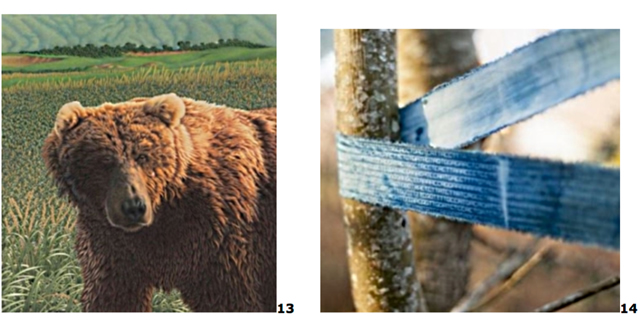

(13) Michael Felber’s concern about species extinction is viscerally sensed from his exquisite, up-close illustration, Grandfather, of the threatened Alaskan brown bear.
(14) Jaden J.A. Hastings’ installation series, On the Subjugation of Nature, is uniquely Anthropocenic – trees are bound by a strip of fabric printed with their sequenced genome.


(15) Lea Kannar-Lichtenberger’s study of the evolutionary dynamics of dandelion weeds provoked her artwork, Life I, questioning our present monoculture agriculture and society.
(16) JM Landin’s Carapace Cornucopia delights in the patterns and colors that result from the adaptive camouflage of turtles — a trait that contributes to their sustainability.
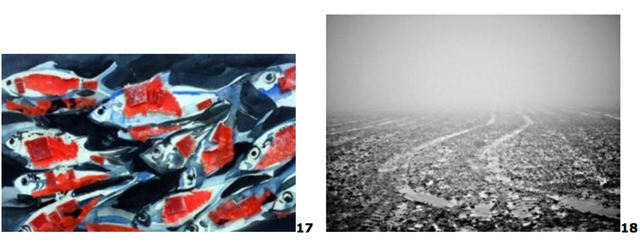

(17) Lee Lee’s Alewives is from her mixed-media DEBRIS series on ocean plastics, which initiated the formation of the international Debris Project that highlights the ecological impacts of single-use plastic.
(18) Jon Wyatt’s photograph, Waterlogged Fields, Monkton, South Wales, is from his The Sixth Extinction series and a result of his field reconnaissance inspired by learning of leading paleogeologists investigating clues in Wales to a 200-million year old global mass extinction event.
FROM-THE-LAB:
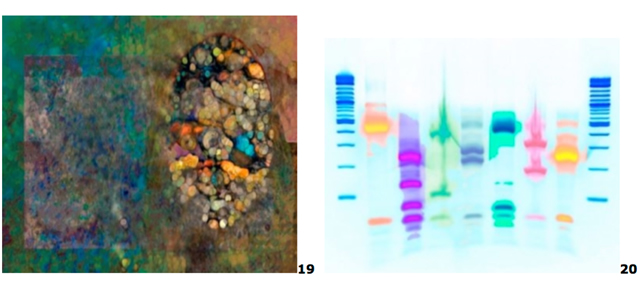

(19) Elizabeth Bajbor’s artwork, Life, emanates from her biological perspective that all life forms are “data storage systems” whose evolved genes can benefit future generations.
(20) Dash Masland’s photograph, It’s a Microbial Matter, prods us to see DNA’s beauty, as well as the crucial role microbes play in conserving our planet’s interconnected web of life.
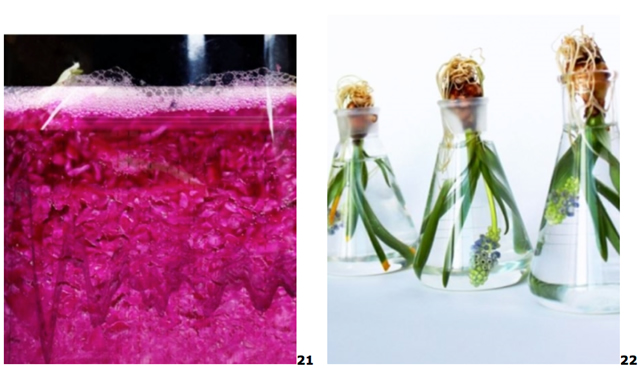

(21) Nadir+Peppermint’s Microbial Selfies series springs from their ingenious electronics and custom software that enables food fermenting bacteria to take “selfies” that reveal the unseen services microbes provide us.
(22) Yoko Shimizu’s intriguing Underwater Efflorescence installation series is from her lab experiment growing flowers to blossom underwater in order to study species adaptation to environmental change.
RITUAL:
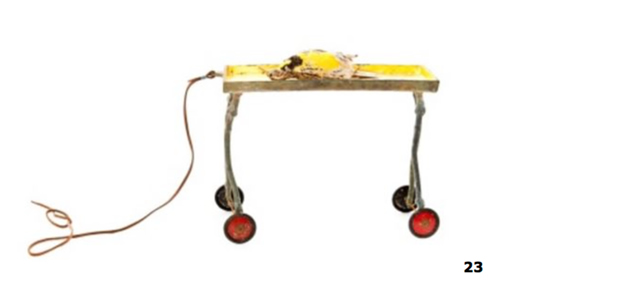

(23) Beth Krensky’s imaginatively crafted Portable Altar and Wish objects are perfect for rituals designed to sanctify and inspire human protection of our rapidly diminishing natural world.
Because scientists are taught not to bring emotions into their research, it is thrilling to see that an increasing number of contemporary artists (and scientists!) are taking on the challenge of using their art to present complex scientific issues in humanistic ways that question our ingrained thinking. Only in this manner will we search for humanistic, cradle- to-grave solutions to today’s most critical problems.
—Cynthia Pannucci, Founder-Director/Art & Science Collaborations and exhibition organizer
See the Online Exhibition’s: Introduction, Co-Juror Statements and Bios, and Artist Pages with all 42 Images, Artist Statements & Website links: www.asci.org/artikel1417.html
ASCI’S Online Exhibition Archive: http://www.asci.org/artikel62.html
(begins in 1992 with The Pull of Kinetics at Snug Harbor Cultural Center, NYC)
Art & Science Collaborations, Inc. (ASCI) is a nonprofit organization with an international membership that is dedicated to raising public awareness of the intersections of art and science as a more holistic way of viewing, learning about, and responding to our inner and outer worlds. Two text+image Historical Reports: www.asci.org/artikel58.html
ASCI’s large archival website features it’s projects and the work of its members: www.asci.org
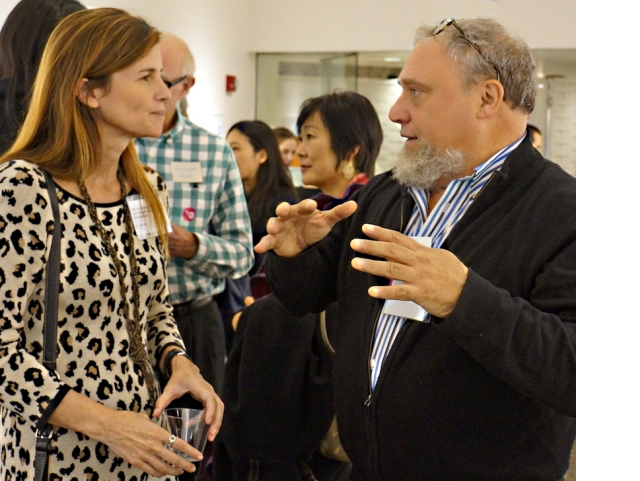

Science co-juror Paula Ehrlich with exhibition artist Jon Goldman. Photograph by Marcia Rudy.
“Being a juror for this show provided me with wonderful insight into the many ways that artists are thinking about engaging people in the important issues of biodiversity and extinction. It was fabulous to attend the artist’s reception and learn more from the artists about what inspired them to create these pieces and how they hope to make a difference in the world through their art.”
—Paula J. Ehrlich, President & CEO of the E.O. Wilson Biodiversity Foundation
Media Coverage

